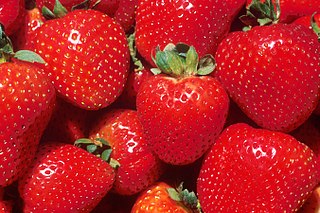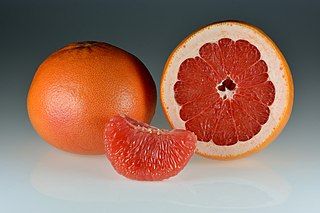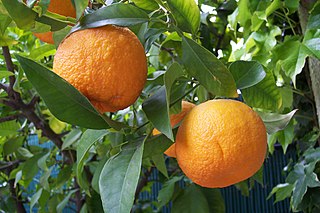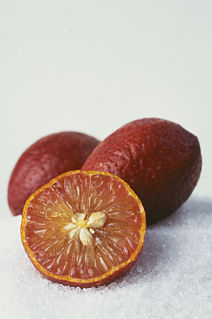
Red is the color at the long wavelength end of the visible spectrum of light, next to orange and opposite violet. It has a dominant wavelength of approximately 625–740 nanometres. It is a primary color in the RGB color model and a secondary color in the CMYK color model, and is the complementary color of cyan. Reds range from the brilliant yellow-tinged scarlet and vermillion to bluish-red crimson, and vary in shade from the pale red pink to the dark red burgundy.

Citrus is a genus of flowering trees and shrubs in the rue family, Rutaceae. Plants in the genus produce citrus fruits, including important crops such as oranges, lemons, grapefruits, pomelos, and limes. The genus Citrus is native to South Asia, East Asia, Southeast Asia, Melanesia, and Australia. Various citrus species have been used and domesticated by indigenous cultures in these areas since ancient times. From there its cultivation spread into Micronesia and Polynesia by the Austronesian expansion ; and to the Middle East and the Mediterranean via the incense trade route, and onwards to Europe and the Americas.

Maclura pomifera, commonly known as the Osage orange, bois d'arc, horse apple, hedge, or hedge apple tree, is a small deciduous tree or large shrub, typically growing about 8 to 15 metres (30–50 ft) tall. The distinctive fruit, a multiple fruit, is roughly spherical, bumpy, 8 to 15 centimetres (3–6 in) in diameter, and turns bright yellow-green in the fall. The fruits secrete a sticky white latex when cut or damaged. Despite the name "Osage orange", it is not related to the orange. It is a member of the mulberry family, Moraceae. Due to its latex secretions and woody pulp, the fruit is typically not eaten by humans and rarely by foraging animals, giving it distinction as an anachronistic "ghost of evolution".

The grapefruit is a subtropical citrus tree known for its relatively large, sour to semi-sweet, somewhat bitter fruit. The interior flesh is segmented and varies in color from pale yellow to dark pink.

Orange is the colour between yellow and red on the spectrum of visible light. Human eyes perceive orange when observing light with a dominant wavelength between roughly 585 and 620 nanometres. In traditional colour theory, it is a secondary colour of pigments, produced by mixing yellow and red. In the RGB colour model, it is a tertiary colour. It is named after the fruit of the same name.

A clementine is a tangor, a citrus fruit hybrid between a willowleaf mandarin orange and a sweet orange, named in honor of Clément Rodier, a French missionary who first discovered and propagated the cultivar in Algeria. The exterior is a deep orange colour with a smooth, glossy appearance. Clementines can be separated into 7 to 14 segments. Similar to tangerines, they tend to be easy to peel. They are typically juicy and sweet, with less acid than oranges. Their oils, like other citrus fruits, contain mostly limonene as well as myrcene, linalool, α-pinene and many complex aromatics.

An orchard is an intentional plantation of trees or shrubs that is maintained for food production. Orchards comprise fruit- or nut-producing trees which are generally grown for commercial production. Orchards are also sometimes a feature of large gardens, where they serve an aesthetic as well as a productive purpose. A fruit garden is generally synonymous with an orchard, although it is set on a smaller non-commercial scale and may emphasize berry shrubs in preference to fruit trees. Most temperate-zone orchards are laid out in a regular grid, with a grazed or mown grass or bare soil base that makes maintenance and fruit gathering easy.

Bitter orange, Seville orange, bigarade orange, or marmalade orange is the citrus tree Citrus × aurantium and its fruit. It is native to Southeast Asia and has been spread by humans to many parts of the world. It is probably a cross between the pomelo, Citrus maxima, and the mandarin orange, Citrus reticulata.

Bixa orellana, also known as achiote, is a shrub native to Central America. Bixa orellana is grown in many countries worldwide.

Blood limes are a hybrid citrus fruit developed by the CSIRO project to investigate salt-resistant crops.

The blood orange is a variety of orange with crimson, almost blood-colored flesh.

The Valencia orange is a sweet orange cultivar named after the famed oranges in València, Spain. It was first hybridized by pioneer American agronomist and land developer William Wolfskill in the mid-19th century on his farm in Santa Ana, southern California, United States, North America.

An orange is a fruit of various citrus species in the family Rutaceae ; it primarily refers to Citrus × sinensis, which is also called sweet orange, to distinguish it from the related Citrus × aurantium, referred to as bitter orange. The sweet orange reproduces asexually ; varieties of sweet orange arise through mutations.

The cam sành or King orange is a citrus hybrid originating in Vietnam.

The Cara Cara navel orange, or red-fleshed navel orange, is an early-to-midseason navel orange believed to have developed as a spontaneous bud mutation on a Washington navel orange tree.

Eliza Tibbets was among early American settlers and founders of Riverside, California; she was an activist in Washington, D.C., for progressive social causes, including freedmen's rights and universal suffrage before going to the West Coast. A spiritualist, she led seances in Riverside. She became known for successfully growing the first two hybrid Washington navel orange trees in California.

Mycena haematopus, commonly known as the bleeding fairy helmet, the burgundydrop bonnet, or the bleeding Mycena, is a species of fungus in the family Mycenaceae, of the order Agaricales. It is widespread and common in Europe and North America, and has also been collected in Japan and Venezuela. It is saprotrophic—meaning that it obtains nutrients by consuming decomposing organic matter—and the fruit bodies appear in small groups or clusters on the decaying logs, trunks, and stumps of deciduous trees, particularly beech. The fungus, first described scientifically in 1799, is classified in the section Lactipedes of the genus Mycena, along with other species that produce a milky or colored latex.

Riverside, California, was founded in 1870, and named for its location beside the Santa Ana River. It became the county seat when Riverside County, California, was established in 1893.

The 'Valencia Pride' mango is a named late-season mango cultivar that originated in south Florida.

The Midknight Valencia orange is a South African variety of the Valencia orange. Its exact origin is unknown, however, around 1927, this variety was first noticed, growing among Valencia orange trees in an orchard at Addo, Eastern Cape, South Africa by A.P. Knight whom the orange was later named after. In following years, more observations were made documenting characteristics of the orange and coming to the conclusion that it should be considered a variety of the Valencia orange.



















